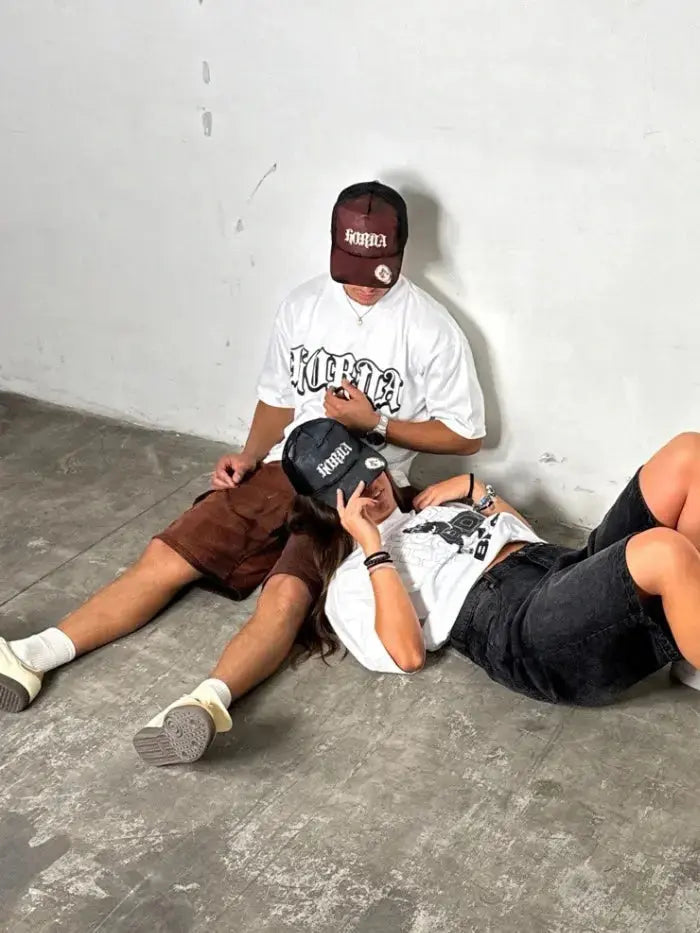Men's streetwear? A fashion that transcends gender and speaks to everyone.
When it comes to "men's streetwear," the collective imagination tends to conjure up a specific urban aesthetic: oversized sweatshirts, cargo pants, boldly printed t-shirts, snapback caps, chunky sneakers. It's a vision rooted in the very origins of streetwear, a trend born on the streets of Los Angeles in the late 1970s and early 1980s, connected to skate, hip-hop, and surf culture. A trend initially designed—or at least communicated—for a predominantly male audience. But are we sure that's still the case? Or, better yet, are we sure it ever really was?
In recent years, the concept of fashion has undergone a radical transformation, driven by growing individual awareness, movements for social and cultural inclusivity, and a digital revolution that has given voice to new generations—freer, more fluid, and more courageous. In this scenario, talking about "men's streetwear" today risks becoming reductive, if not downright misleading. Streetwear, though born in male circles, has become a universal stylistic language, a visual code that transcends gender and adapts to the identity of anyone who wishes to use it to express themselves.
What until recently was considered "men's fashion" is now worn by people of all genders. This isn't because women are "borrowing" clothes from the men's wardrobe, but because streetwear, by its very nature, doesn't fit into any binary category. It's a fashion born to break the mold, not to create it. It's a style that celebrates freedom, independence, and originality. And in this context, the limitations imposed by gender become completely meaningless.
Just look at the collections of the most iconic brands to understand this. Supreme, Off-White, Stüssy, Carhartt, Nike, and Adidas, to name a few, offer garments that, while sometimes labeled "men's" or "women's," are actually designed to be worn by anyone. The silhouettes are deliberately oversized, the cuts are loose, the colors are versatile. The hoodies, graphic T-shirts, baggy pants, and chunky sneakers make no distinction. And while gender distinctions once served to determine marketing and distribution choices, today the public demands something different: authenticity, accessibility, and identity.
The shift is also visible in visual communication. Advertising campaigns for major fashion houses and emerging brands feature male and female models wearing the same pieces. Styling is deliberately neutral, the narrative inclusive. International fashion week runways, from Milan to New York, feature increasingly genderless shows. Social media, a powerful tool in redefining aesthetic standards, are amplifying this trend thanks to influencers, designers, and fashion enthusiasts who propose label-free streetwear outfits.
An interesting phenomenon concerns the strategic use of the keyword "men's streetwear" in online searches. Users type this term seeking inspiration, style tips, new collections, or sneaker styles, but what they find is an increasingly hybrid visual universe, where the same hoodies or jackets are worn by male and female models without distinction. SEO, in this case, almost becomes a lens for observing the cultural shift underway: starting with a keyword that presupposes a masculine identity, we arrive at a world where that definition loses its rigidity, opens up, and transforms.
Furthermore, streetwear perfectly meets the needs of a generation that prioritizes comfort, functionality, sustainability, and the symbolic value of garments. Wearing a sweatshirt with the logo of an independent brand or a pair of limited-edition sneakers means taking a stand, declaring belonging, and crafting a personal narrative. And all of this has nothing to do with gender. In fact, new trends are moving in the exact opposite direction: the more shareable, adaptable, and transformable a garment is, the more valuable it becomes. Hence the growing success of unisex capsule collections, fluid sizes, and minimalist designs that speak a transversal language.
In Italy, this shift is visible not only in major urban centers but also in local communities. Streetwear stores that are more attentive to new sensibilities offer mixed-use window displays, with no clear separation between "men's" and "women's" departments. Trade fairs, pop-up stores, and online marketplaces present catalogs filtered by size or style, but increasingly less by gender. Streetwear thus becomes the manifesto of a generation that rejects the confines of imposed identity and builds itself freely, piece by piece, accessory by accessory.
Streetwear's aesthetic is also evolving alongside this inclusive vision. Colors are becoming more diverse, prints are daring in bold combinations, materials are becoming more refined, and collaborations between designers and artists are adding cultural and creative value to urban fashion. The result is a style that continually evolves, drawing on elements of high fashion, industrial design, and pop culture. And once again, this process of hybridization transcends gender boundaries.
Streetwear isn't masculine, it's not feminine: it's human. It's a bridge between styles and identities, between cultures and generations, between past and future. It's a blank canvas on which everyone can paint their own vision of the world. And precisely for this reason, it's the fashion of the present and, undoubtedly, that of the future. Those who search for "men's streetwear" today often find something much more expansive: a possibility. An open door. A way to be yourself.
Ultimately, what really matters in streetwear isn't who a piece is for, but what it says about the wearer. Fashion, after all, has always been a language. And the most powerful language is one that includes, unites, and gives voice.
https://hordabrand.com
